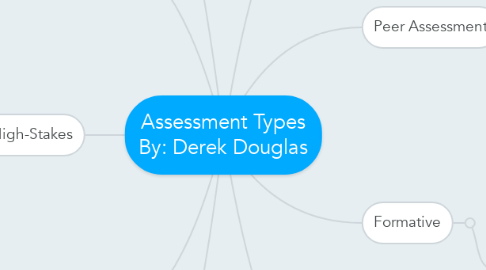
1. Self-Assessment
1.1. Definition: Self assessment means the process of having the learners critically reflect upon, record the progress of and perhaps suggest grades for, their own learning. (http://www.bristol.ac.uk/esu/e-learning/support/tools/Self-and-peer-assessment/)
1.1.1. Example: After an essay was handed in by a social studies class it is handed back to the student to propose a grade and analyze their work.
1.1.2. Advantage: Inspires self reflection, can help teachers focus feedback, and help the students become autonomous learners.
1.1.3. Disadvantages: Students might not look at their work objectively and give themselves inaccurate grades, or be to critical of their work.
2. Authentic
2.1. Definition: An assessment that measures a student's ability to perform a “real world” task in the way professionals in the field would perform it. (Northern Illinois University, http://www.niu.edu/assessment/Resources/Assessment_Glossary.htm, accessed 1/26/15)
2.1.1. Example: A social studies student writes a research paper on farming equipment in the Middle Ages, just like a scholar would.
2.1.2. Advantage: Students can see the value or application of material and content knowledge.
2.1.3. Disadvantage: Some "real world" task are not suitable or comprehensible in the classroom. I.e a person cannot understand the "feeling" or "emotion" of a society without going there or being in a very similar experience.
3. Performance-Based
3.1. Definition: A method for assessing how well students use their knowledge and skills in order to do something. (Northern Illinois University, http://www.niu.edu/assessment/Resources/Assessment_Glossary.htm, accessed 1/26/15)
3.1.1. Example: Social studies students are asked to explain in a well-written persuasive essay what aspect of the Arab Spring allowed it spread throughout the Middle East.
3.1.2. Advantage: Students can demonstrate their knowledge of the content to the instructor.
3.1.3. Disadvantage: Students may feel restricted in the medium in which they must demonstrate their content knowledge.
4. Portfolio
4.1. Definition: A collection of a student's work specifically selected to tell a particular story about the student Source: http://jfmueller.faculty.noctrl.edu/toolbox/portfolios.htm
4.1.1. Example: Social studies students must keep a collection of their mapping assignments, with the ultimate goal of creating their own map utilizing all of their previous work and skills.
4.1.2. Advantage: Students and teachers can see how the content builds more and more knowledge on a subject.
4.1.3. Disadvantage: Students being unable to recognize the important aspects of their portfolio. They must be able to look at the information as both a single whole, and a collection of single parts.
5. High-Stakes
5.1. Definition: The decision to use the results of assessment to set a hurdle that needs to be cleared for completing a program of study, receiving certification, or moving to the next level. Most often the assessment so used is externally developed, based on set standards, carried out in a secure testing situation, and administered at a single point in time. (Northern Illinois University, http://www.niu.edu/assessment/Resources/Assessment_Glossary.htm, accessed 1/26/15)
5.1.1. Example: A Social Studies final exam that must be passed to receive credit for the course.
5.1.2. Advantage: Sets a benchmark that all students must strive to achieve and excel at. It also allows classes to be standardized.
5.1.3. Disadvantage: Can create high stress for students and can inadequately express students diverse ways of demonstrating content competency.
6. Peer Assessment
6.1. Definition: Peer assessment means the process of having the learners critically reflect upon, record the progress of and perhaps suggest grades for, a peers learning. (http://www.bristol.ac.uk/esu/e-learning/support/tools/Self-and-peer-assessment/)
6.1.1. Example: Before a social studies essay is handed in, it must be peer edited and "graded" by a fellow student.
6.1.2. Advantages: Inspires collaboration and new ideas. Exposes students to different opinions or perspectives using the same content as a base.
6.1.3. Disadvantages: Pairings can be imbalanced, providing one student with excellent feedback, while the other recieves few benifits.
7. Summative
7.1. Definition: Assessment that is done at the conclusion of a course or some larger instructional period (e.g., at the end of the program). The purpose is to determine success or to what extent the program/project/course met its goals. (Northern Illinois University, http://www.niu.edu/assessment/Resources/Assessment_Glossary.htm, accessed 1/26/15)
7.1.1. Example: After the unit on Physical Maps, the social studies students must take a test where they must label the map correctly, using the skills they have learned from the unit.
7.1.2. Advantages: The teacher is able to get a clear understanding whether or not the student has acquired the required skills to pass the course, or find areas that need to be reinforced.
7.1.3. Disadvantages: Many students suffer from test anxiety and may inaccurately demonstrate their knowledge on the test or assessment.
8. Formative
8.1. Definition: The gathering of information about student learning during the progression of a course or program and usually repeatedly-to improve the learning of those students. Assessment feedback is short term in duration (Northern Illinois University, http://www.niu.edu/assessment/Resources/Assessment_Glossary.htm, accessed 1/26/15)
8.1.1. Example: After explaining the importance the heavy plow to the class, I ask them if they can name other important revolutionary inventions throughout history. Their answers will indicate whether or not they grasp the importance of the heavy plow.
8.1.2. Advantages: Able to receive real-time information on students understanding of material or ideas
8.1.3. Disadvantages: Grades cannot usually be assigned to formative assessments. So other incentives have to be present.
9. Diagnostic
9.1. Definition: Diagnostic assessment is an essential device in a teacher’s “tool kit”. It can be used to diagnose strengths and areas of need in all students. Diagnostic assessment involves the gathering and careful evaluation of detailed data using students’ knowledge and skills in a given learning area. (http://www.education.nt.gov.au/parents-community/assessment-reporting/diagnostic-assessments/diagnostic-assessments)
9.1.1. Example: Before starting a new unit on the Renaissance, a social studies teacher asks the students to write an essay on everything they know about the subject. This will help the teacher determine which aspects will need more attention in class than others.
9.1.2. Advantages: It provides the teacher with valuable information to help the students learn as effectively as possible.
9.1.3. Disadvantages: The results may be confusing or inaccurate. The students may have surface knowledge about a subject but are unable to apply any of that knowledge.
